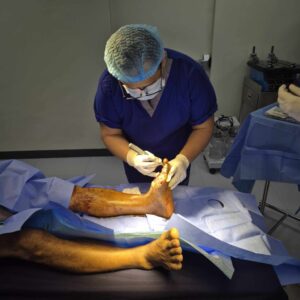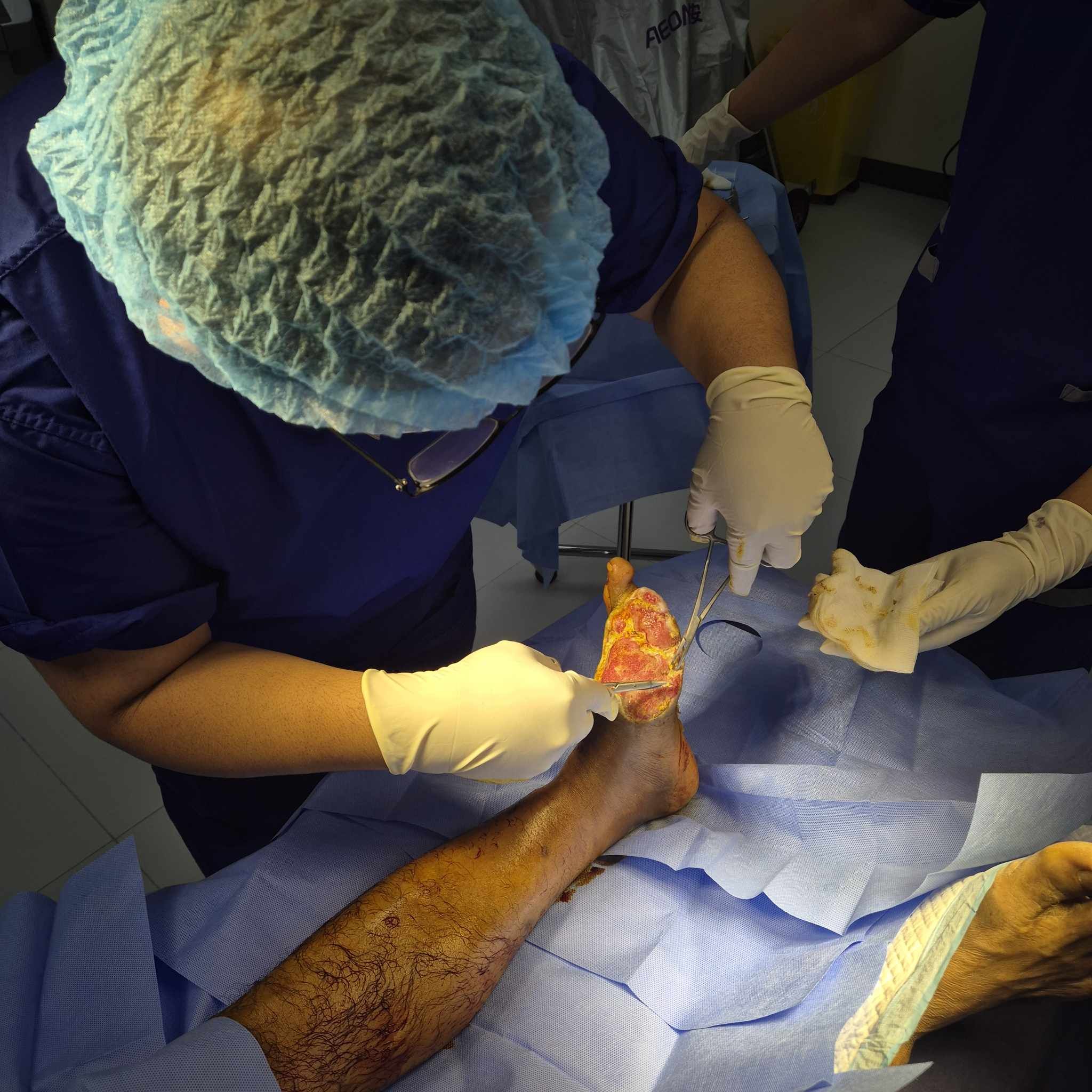Debridement Services provide a vital foundation for proper wound care because many wounds fail to repair themselves when dead or damaged tissue remains on the surface. When this unwanted tissue builds up, the body struggles to form healthy cells, and the risk of infection rises. Debridement Services remove these obstacles through carefully selected methods performed by trained wound care specialists. Patients dealing with chronic wounds, surgical wounds, pressure sores, diabetic ulcers, and tissue damage from injuries often rely on Debridement Services to support recovery and prevent complications. This article explains what Debridement Services involve, who needs them, the different methods used, and how professional care contributes to safer and steady healing progress.
What Debridement Services Are and Why They Matter
Debridement Services refer to the targeted removal of dead, infected, or unhealthy tissue that slows down or blocks healing. This type of tissue may appear soft, leathery, dark, or foul-smelling depending on the wound’s condition. Without professional removal, new tissue cannot form properly, and harmful bacteria may multiply. Debridement Services help clear the wound surface so fresh cells can grow with better circulation and a cleaner environment.
Many wounds, especially long-lasting or complicated ones, react positively once debris, necrotic tissue, and contaminants are removed. Debridement Services achieve this through methods chosen based on wound severity, patient comfort, and specific medical needs. Professional supervision is essential because each wound behaves differently, and unsafe handling of tissue can lead to deeper injury, bleeding, or infection. Clinics offering Debridement Services typically rely on advanced tools, updated techniques, and a clear treatment protocol to protect patient safety from start to finish.
Types of Debridement Services Offered at Trusted Wound Care Facilities
Professional wound care centers offer several types of Debridement Services. Each method serves a different purpose, and specialists determine the ideal option during assessment.
Mechanical Debridement
Mechanical Debridement Services use physical force to clear unwanted tissue. Options may include gentle irrigation, wound scrubbing, or specialized dressings that lift dead tissue as they are removed. This approach is often used for wounds with moderate necrotic buildup. It helps stimulate surface cleaning and can prepare the wound for more precise techniques. Mechanical methods are widely used yet must be handled with care to avoid skin irritation.
Ultrasonic Debridement
Ultrasonic Debridement Services rely on low-frequency sound waves delivered through specialized instruments. These tools break down necrotic tissue without harming healthy skin. Patients appreciate ultrasonic methods for their comfort, accuracy, and efficiency. This technique is especially valuable for chronic wounds, diabetic ulcers, and wounds with irregular depths. Ultrasonic Debridement Services allow specialists to reach stubborn tissue pockets that are difficult to manage through manual means.
Sharp or Surgical Debridement
Sharp Debridement Services involve the skilled use of scalpels, curettes, or scissors to remove dead tissue quickly. This method is chosen when a wound has thick, extensive, or deep layers of necrosis that require immediate removal. It is one of the fastest ways to prepare the wound bed and is performed only by trained professionals. Patients who need rapid improvement or infection control often benefit from this level of precision.
Autolytic and Enzymatic Options
Autolytic Debridement Services use moisture-balancing dressings to help the body soften and dissolve dead tissue naturally. Enzymatic options involve topical solutions that break down necrotic tissue layer by layer. These methods are gentle and suitable for patients who prefer less discomfort or have wounds in sensitive areas. Although these approaches take more time, they remain highly effective when supervised properly.
Who Can Benefit from Debridement Services
Debridement Services help a wide range of patients, especially those who struggle with slow-healing or complicated wounds. Individuals with diabetic foot ulcers often rely on Debridement Services because these wounds frequently develop necrotic layers that block proper healing. Patients with pressure sores also benefit because dead tissue commonly forms due to prolonged pressure and lack of oxygen.
Individuals recovering from surgery may require Debridement Services if their wounds fail to progress as expected or if tissue death forms around the incision. People with traumatic injuries may also develop damaged tissue that needs professional clearing. Patients with persistent inflammation, unusual discharge, or a foul odor around the wound often require Debridement Services to restore a healthier healing environment.
Key Signs a Wound May Require Debridement Services
There are several signs that often indicate a strong need for Debridement Services. A wound that produces a dark, leathery, or foul-smelling layer likely contains necrotic tissue. Slow or stalled healing is another common sign because healthy cells cannot grow when dead tissue blocks circulation.
Wounds that remain swollen, irritated, or excessively moist may also require Debridement Services. Any wound that shows signs of contamination or infection, including unusual drainage or persistent discoloration, should be evaluated quickly. When a wound fails to improve after several days of basic care, a professional assessment becomes necessary to determine whether Debridement Services should begin.
How Professional Debridement Services Support Recovery
Debridement Services help create the right environment for new tissue to form. Once necrotic and infected layers are removed, oxygen and nutrients circulate more effectively around the wound. This promotes faster regeneration and improves the impact of dressings and medications.
With Debridement Services, the risk of bacterial growth decreases significantly. Harmful microorganisms often thrive in dead tissue. Clearing this tissue removes their breeding ground. Patients gain better comfort and mobility as inflammation subsides and pain lessens. Debridement Services also prepare the wound for advanced treatments such as grafting, compression therapy, or advanced dressings.
Step-by-Step Guide to the Debridement Procedure
Initial Evaluation and Diagnosis
Debridement Services begin with a comprehensive assessment. Specialists examine the wound’s size, depth, color, odor, and texture. They also consider the patient’s medical history, circulation, and risk factors such as diabetes or vascular conditions. This thorough evaluation identifies the safest and most effective technique.
Selection of the Appropriate Technique
Debridement Services are not performed the same way for every patient. Specialists choose the method based on the wound’s stage, tissue type, patient comfort level, and urgency. Some wounds require slow, gentle methods, while others need rapid intervention.
Tissue Removal and Cleaning
During Debridement Services, the provider removes dead tissue using the chosen technique. Mechanical, ultrasonic, or sharp instruments may be used. Each step prioritizes precision and patient comfort. Once tissue is cleared, the wound is carefully cleaned to reduce contamination.
Dressing Application and Protection
Dressings play an important role after Debridement Services. Specialists may apply moisture-balancing dressings, antimicrobial pads, or protective coverings to support recovery. These dressings help keep the wound clean and promote healthy tissue growth.
Monitoring and Follow-Up Care
Debridement Services often require repeated visits based on the wound’s progress. Specialists monitor healing, adjust dressings, and recommend additional sessions when necessary. This continual support ensures safer and more predictable recovery results.
Why Professional Debridement Services Are Safer Than Self-Treatment
Attempting to remove dead tissue at home is extremely risky. Without proper tools and sterile technique, a person may worsen the wound, damage healthy tissue, or trigger severe infection. Debridement Services performed by professionals eliminate these risks. Specialists follow medical standards, maintain sterile conditions, and use techniques that protect surrounding skin. Professional care also identifies deeper issues that may not be visible to the patient.
Aftercare Guidance for Patients
After Debridement Services, proper home care plays a major role in long-term recovery. Patients are usually advised to clean the wound gently, change dressings as directed, and follow hygiene guidelines. Nutrition rich in protein, vitamins, and iron supports tissue repair. Footwear adjustments, mobility support, and pressure-relief techniques may be recommended for certain patients. Regular follow-up appointments ensure the wound continues healing without setbacks.
Choosing a Reliable Provider for Debridement Services
Selecting the right clinic for Debridement Services contributes greatly to healing success. Patients should look for trained wound care specialists, modern tools such as ultrasonic technology, and a clinic with a strong track record in handling chronic or complex wounds. A reliable provider ensures patient comfort, explains each step clearly, and tailors treatments to the patient’s condition.
FAQ Section
How often are Debridement Services needed?
Frequency depends on wound severity. Some patients require multiple sessions, while others benefit from a single procedure followed by monitoring.
Do Debridement Services cause pain?
Discomfort varies based on the method and wound condition. Clinics typically use techniques that minimize pain and support patient comfort.
How long does healing take after Debridement Services?
Healing time varies. Many patients notice improvement within days, while complex wounds may require weeks or months.
What types of wounds respond best to Debridement Services?
Chronic wounds, diabetic ulcers, pressure sores, surgical wounds, and infected wounds often respond well.
Can Debridement Services prevent complications?
Yes. Removing dead tissue reduces the risk of infection and helps the wound progress through natural healing stages more effectively.











